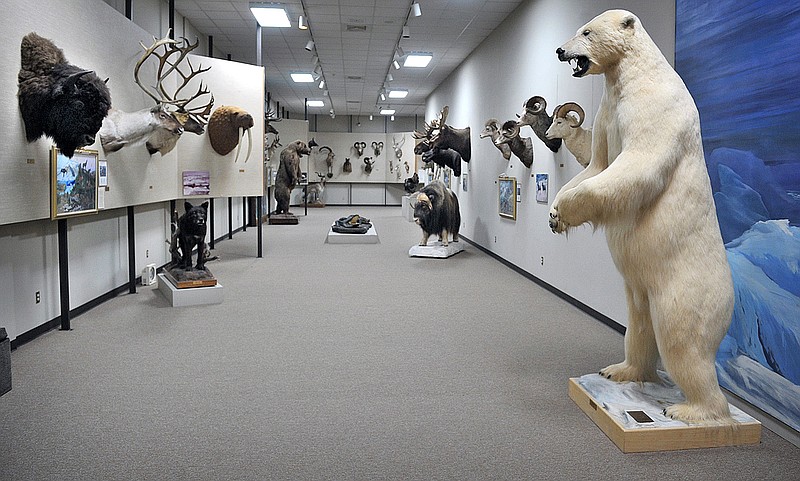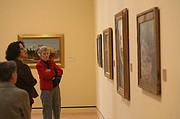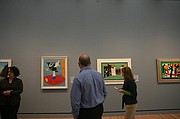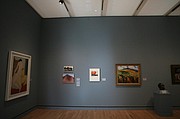VERNON, Texas-"If you don't know history, you don't know anything. You are a leaf that doesn't know it's part of a tree"-Michael Crichton, writer and filmmaker
There are perhaps no truer words regarding where people come from, where they've been and how they've arrived than those from screenwriter and filmmaker Michael Crichton. Stories and keepsakes are passed down from generation to generation so successors don't forget about their predecessors; rather they remember what set the course for their forefathers that led them to where they are today.
Museums are often the location where artifacts and treasures end up for display to take people down memory lane or introduce people to interesting tidbits they didn't know. The Red River Valley Museum in Vernon is one of those locations in this area, capturing North Texas history beginning with its prehistoric days.But, it's not just about capturing yesterday's history.
"History doesn't end today," museum board president Bobby Burrus told the Wichita Falls Times Record News. "History continues. So, why don't we continue to tell our story. Hopefully there's going to be the birth of a young person today that's going to go on and do something similar to what the Waggoner family did; something similar to what the Wright family did; something similar to what the Sumner family did.
"All of these families that were pioneers here developed something extraordinary, I think we can up lift them (today's youth) and let them know they can do it."
Wilbarger County District Attorney Staley Heatly joined the museum board in about 2005, having grown up in Vernon and seeing the displays of area history since the museum opened in the early 1980s. He became president of the board in 2012, and the group was looking at a multimillion dollar project to revive the museum.
Displays had, for the most part, gone unchanged including the massive J. Henry and Ethel Ray collection of Native American and prehistoric artifacts, pieces that began the rumblings of a historical gallery in the Wilbarger County seat in the 1960s. More than 130 pieces of the William Bond Wild Game collection as well as the history of the Waggoner Ranch became permanent fixtures, too.While the relics did provide a glimpse into the past of Vernon and the county, it really didn't tell the story. The area played a significant role in the Great Western Cattle Trail, specifically with the establishment of Doan's Crossing, the first trading post along the trail on the Red River, in 1878.
Heatly said the board took stock in 2012 of what items they had in the museum-even those in the basement-and realized they already had an extraordinary museum, but it just needed to be improved.
"What we decided to do is let's take a look at what we have in this building, the exhibits that we've had, and I think we'd kind of just forgotten how special they were," he said. "We had kind of forgotten because things had been the same for maybe 20 years since this building was built and the exhibits were put in. They had remained the same, and we had forgotten what we had."
The museum began the Western Trail Campaign in 2014 after taking inventory, setting the bar low, Heatly said, regarding what it would cost to recreate the interior of the facility. They soon realized it would take much more than that to create exciting, interactive and interesting displays that capture the mind, hearts and imaginations of guests of all ages. The fundraising goal ballooned to about $700,000, and a grant from the Priddy Foundation in Wichita Falls was the catalyst to get well-known Wilbarger County families and others to join in the effort. The city also provided local hotel/motel tax money for the project.Heatly said it wasn't easy, but just over $750,000 was raised for the project, leaving some leftover funds for the next couple phases after the main display area was remodeled by Exhibit Concepts, a group that worked on the Oklahoma City National Memorial Center as well as the National Museum of the Pacific War in Fredericksburg, Texas.
The new Red River Valley Museum held its official grand opening in
December 2015.
"It exceeded our expectations," Heatly said. "We're all pretty blown away that we have a facility like this in Vernon, Texas. I think that when people walk in to this museum, they're amazed that in a town the size of Vernon, we have a facility that's such high quality."
What's a museum without cool things to look at, interesting factoids that bring a homeliness to the atmosphere and some flashing lights to elevate the level of excitement? Red River Valley Museum has those features now, including audio recording to provide information to guests and special effects to assist in the storytelling.
Sherry Yoakum, museum executive director, has a passion that's just as electrifying as the displays in the museum. From a 200 million-year-old fossil found in Wilbarger County coveted by the Smithsonian to a historic flint cache to an animatronic cattle drover to history of Doan's Crossing, Yoakum
"A lot of museums have artifacts that are amazing, but they're not as defined as ours," she said of the prehistoric fossil and mastodon teeth and jawbones, but could easily apply to other displays. "That's why so many people come here. We've got a shark's tooth. That proves we had freshwater sharks here. We were under water; 10,000 years ago you would've been swimming here."
Fossils are just the beginning of relics that capture the vast changes the land and cultures have gone through over the years. Clovis points from the Native American Clovis tribe are hints that trading among tribes went on in North Texas. Tools such as arrows used in the 18th and 19th centuries and stones rubbed with animal fat to make war paint are also on display.
The story of Doan's Crossing has flashes of brilliance, using its choreographed lightning to coincide with the lightning strike that spurred a cattle stampede. A Doan's May Picnic display has a permanent place on the floor instead of its traditional unveil during the annual celebration. There are also slide out board and wall-mounted displays that share the history of prominent settlers and families that helped building and shape communities in Wilbarger County.
Burrus, an Edward Jones financial adviser, said the next phase is to begin reinventing and reinvigorating the largest display of Waggoner Ranch history in
location.
"This is exciting," said Burrus, a 15-year member of the board. "You can walk through the museum and you'll see that the exhibits are something you'd see in the (Dallas-Fort Worth) metroplex. It's exciting to have this here in Vernon. We could've continued the same old path of just let's dust off things and keep going, but Staley's leadership came in and brought new vibrancy and new life to us, so we looked at our collections and said we need to do
something better."
While Burrus, Yoakum and others might send accolades the way of the district attorney, Heatly said the achievements made by the museum required more than one person. It required
a community.
He said the board sought to include people in Vernon and surrounding communities from the very beginning of the project to share their vision of what they wanted the large display room and museum to be. It purposefully wasn't intended for only those who would donate to the campaign, but to get the stories of generations of people in the area who contributed to
its growth.
"We included as many people as we could-subject matter experts on the Great Western (Cattle) Trail or on Doan's Crossing and Doan's (May) Picnic-so that we were bringing in the community and getting buy-in from the whole community," Heatly said. "If you're going to have a project like this and have it be successful you've got to have buy-in from a number of different people in
the community."




